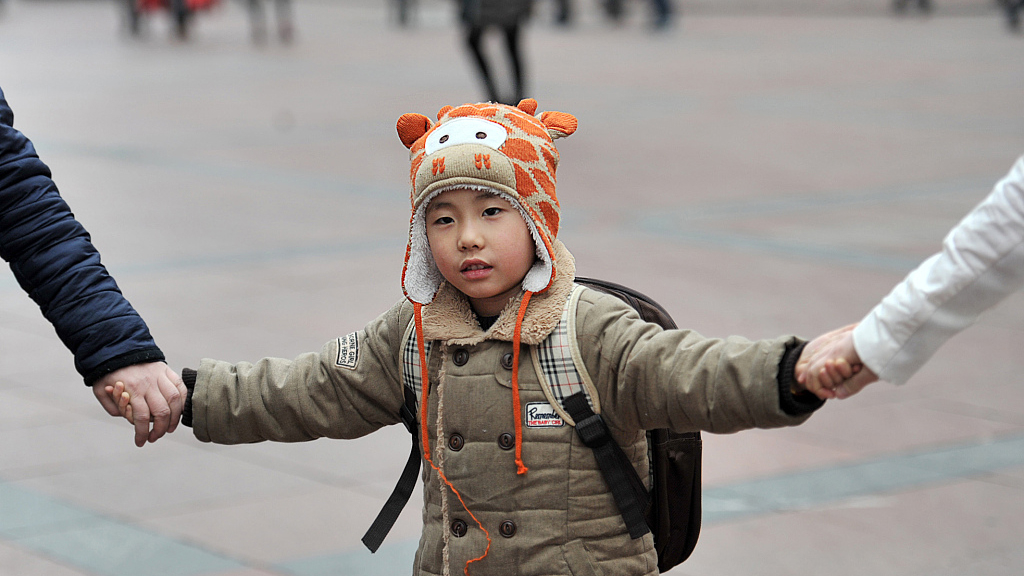
Domestic
17:06, 09-Mar-2019
Study: China's population will peak around late 2020s
By Li Jianhua
03:42

China, now the world's most populous country, is losing the very momentum that gives it that title. More people are opting not to have second children or any children at all. Various reasons are leading to this scenario, which may lead to consequences in the long run, both internally and externally.
Official figures from the National Statistics Bureau (NSB) indicate the nation's birthrate has dropped to its lowest since the People's Republic of China was founded 70 years ago, despite the government's efforts to loosen population control measures.
Multiple measures have been adopted to boost the number of babies born, but the birthrate in 2018 stood at 1.094, while the figure in 2017 was around 1.243, according to data from the bureau. The number needed to maintain a healthy demographic structure is around 2.1.
According to NSB data, the number of babies born in 2018 stood at 15.23 million.
China is not alone, as the birthrate in South Korea dropped to 0.98 in 2018, according to a recent study published on JoongAng Ilbo. Experts say declining birthrates have become a global trend.
“Since China introduced the second child policy in 2016, the birthrate definitely spiked at first, even though our hospital set an entrance quota. And in 2018 the number saw an eight to ten percent decline,” said Professor Wang Zilian of First Affiliated Hospital, Sun Yat-sen University.
Wang said the number of would-be mothers is higher in other hospitals – since her hospital employs the entrance quota system – but they have all witnessed a birthrate decline despite the two-child policy.
China's child policy & youngsters' attitudes
Research shows China's population will peak around late 2020s, and experts predict the peak shouldn't make too much of a difference, even if the government relaxes its current policies even further.
The “second-child” policy was introduced in two phases in 2014 and 2016. In the 2014 version, a couple could have two children on condition that either the husband or the wife was an only child; while the limit was lifted completely in the 2016 version.
China's “only-child” policy was introduced in the late 1970s, with an exemption for ethnic minorities. Families with Han ethnicity – the majority of the Chinese population – were fined if found giving birth to two children. Worse, they could lose their jobs, especially those who held government-related work. Nevertheless, some Chinese Han families still opted to have two children or more.
CGTN hit the streets of several Chinese cities and asked young people about their attitudes towards childbearing. Here are some of their responses:
“That depends. I'd like to give my children the best. If my financial situation improves, I would have more kids.”
“Children's education. The daily expenses of a child are also quite high. These are the main factors. Too much pressure.”
“My children have nice playmates. Many are only children though, so I guess they must be lonely. Also, they can talk to each other if they are in trouble when growing up.”
“I don't want a second child. One is good enough. It's too troublesome to have two children.”
Professor Wang said older women are more willing to have a second child than their younger counterparts.
“High-risk childbearing women are increasing," she said. "Standards of China's maternity insurance were set during the one-child period. But now the situation is different. I hope maternity insurance policies can be adjusted accordingly.”
China's “demographic dividend” disappearing?
The demographic dividend, according to the United Nations Population Fund (UNFPA), refers to the “economic growth potential that can result from shifts in a population's age structure – mainly when the share of the working-age population (15 to 64) is larger than the non-working-age share of the population (14 and younger, and 65 and older).”
“Population aging is getting more severe," said Professor Zheng Zhenzhen of Population and Labor Economics, Chinese Academy of Social Sciences. "This is the biggest impact. If we can foresee the change in population and make preparations, it would not be a big problem. But the problem is we must know the consequences it may bring to our society.
“Most women choose to give birth in their 20s and 30s, which is also the prime time for career development. They conflict. If the family and society could lend a hand, China's birthrate could see an uptick.”
Back in 2012, when China witnessed the first decrease in the size of its labor force, the People's Daily quoted an expert as saying China's demographic dividend had been disappearing since 2012, which would have a significant impact on the country's economic growth.
GDP growth has been dwindling to single digits and China has recently set the growth rate at somewhere between 6.0 and 6.5, but no evidence has shown this is related to the change of the nation's demographic structure.
Fast forward to 2019, the top statistics official Ning Jizhe went on record as saying that the demographic dividend still exists and there is no need to over-interpret the dipping population growth rate and birthrate.
"Demographic data should be analyzed in a long-term perspective, and the demographic structure changes with the development of economy and society and is a natural process," said Ning Jizhe, head of National Statistics Bureau.
Ning said the improving quality of the workforce, as well as about eight million fresh college graduates each year, will help propel China's industrial upgrading and unleash innovation momentum in sustaining China's medium and long-term steady economic expansion.
(Chen Jiaye, Xu Xinchen, Zhao Yunfei, and Zong Jinyi contributed to the story.)

SITEMAP
Copyright © 2018 CGTN. Beijing ICP prepared NO.16065310-3
Copyright © 2018 CGTN. Beijing ICP prepared NO.16065310-3